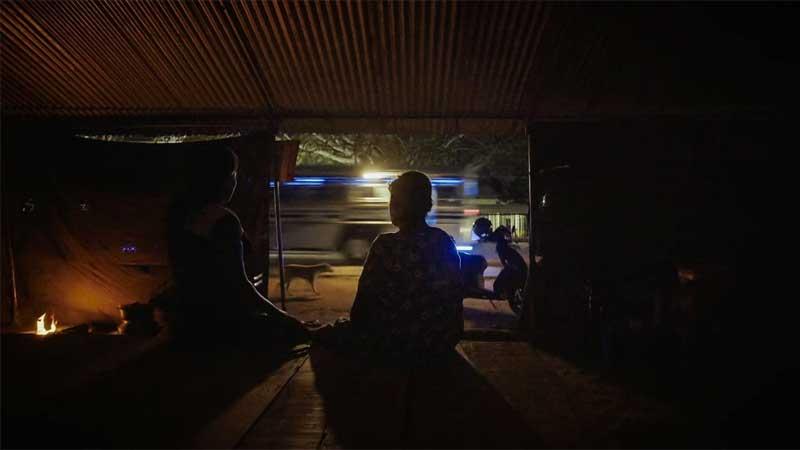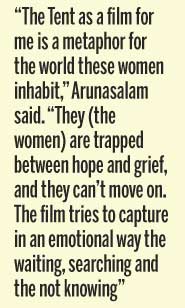
Picture this, one screen shows a couple of women. They are in a tent set up next to a government building. Outside, the state officers come and go. The women continue to sit in their make-shift tent, day and night, in the scorching sun and pouring rain. They make tea, and sometimes share it with the security officer guarding the state building.
The other screen depicts a much busier day. It is an anniversary. There are more women, more movement, and then there are the media.
In his new dual projection film installation documentary filmmaker Kannan Arunasalam intimately follows a group of women in their wait for answers promised by the sitting government. Answers to what happened to their disappeared loved one.
 During the Sri Lanka military and Liberation Tigers of Tamil Eelam (LTTE) conflict thousands of Tamil civilians disappeared. They included those who surrendered to the military towards the war end. When the Maithripala Sirisena led government came to power the families of the disappeared were promised answers for these multiple ‘disappearances’. The promises never materialized- to date.
During the Sri Lanka military and Liberation Tigers of Tamil Eelam (LTTE) conflict thousands of Tamil civilians disappeared. They included those who surrendered to the military towards the war end. When the Maithripala Sirisena led government came to power the families of the disappeared were promised answers for these multiple ‘disappearances’. The promises never materialized- to date.
In exhaustion, the family members resorted to organizing protests across the north. One of these was held in a petite tent in Mulativu. Arunasalam’s The Tent depicts the incredible fight of the women who took refuge in this makeshift, metal roofed, cloth covered shelter.
From August 28 to 29 the public will get the opportunity to experience the women’s movement as The Tent is set to screen - 10.00am/ 8.00pm on both days at the JDA Perera Gallery No 46, Horton Place, Colombo 7. The exhibition will then be held from September 3 to 11 at the Thanthai Chelva Auditorium (Jaffna Central College), number 114, Rajendra Prasad Road, Jaffna. Hosted the SJV Chelvanayagam Memorial Trust.
The silent vigils of the women are still continuing, the exhibition marks their 900th day!
Screening of the dual projection film will be held alongside a selection of photographs by Stephen Champion who has been developing new work in Sri Lanka since 1986.
A few months ago, Arunasalam invited Champion to join him in the anticipated exhibitions in Colombo and Jaffna. Champion selected 25 of his photographs to be showcased alongside Arunasalam’s The Tent.
The photographs are a series from photographic negative film and print archive Champion created for the past 33 years. Champion’s work also includes the plight of families whose loved ones disappeared during the JVP insurrection.
Arunasalam’s objective by making the film and the photo exhibition is to echo earlier movements by the Jaffna mothers’ front in 1984 who demanded the release of their children taken in by the military, and the movement by Southern mothers’ front in 1990 who wanted answers from the state and non-state actors for the disappearances of their children, too.
Amnesty International states, ‘since the late 1980s, Sri Lanka has a backlog of 60,000 to 100,000 alleged disappearances’.
In this regard, Arunasalam wanted to capture the events that unfolded in the lives of the protesting women,who were waiting for years to know what happened to their loved family member, during much quite days, the non-anniversary days, when the media was nowhere in the horizon.
“The Tent as a film for me is a metaphor for the world these women inhabit,” Arunasalam said. “They (the women) are trapped between hope and grief, and they can’t move on. The film tries to capture in an emotional way the waiting, searching and the not knowing.” When Arunasalam visited the women during a what he calls a ‘quite day’ the happenings captured his interest. It took some time to convince them to let him observe what a non-media day was like and then to document the event intimately.
“When I went on one of these days it was just two or three women holding the fort and marking the days. I found that extremely moving,” he said, because what most see is when the media goes to cover an anniversary event when hundreds of families of the other disappeared persons also visited.
Arunasalam said people do not usually see the quieter days. He wanted people to see just that.
“Because those were the days there was a compelling feeling of loss,” he points out.
These days shows how two women wake in the mornings, go about their household chores, make tea, prepare the firewood, and prepare the space for the next media event, while braving the extremes of the weather - All under strict surveillance by the army. Another key objective by the anticipated exhibition and film installation is to rekindle the sense of solidarity between the North and the South, and then to create a conversation around the heartlessness around the disappearance of thousands. A brother, a father, a daughter, or a husband who mysteriously and suddenly missing, and who are are expected to be simply forgotten, as far as ‘those in power’ are concerned.
